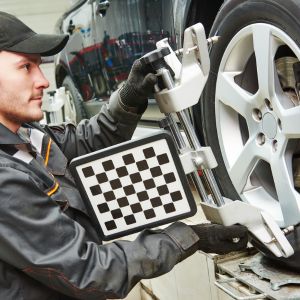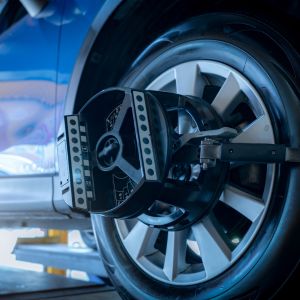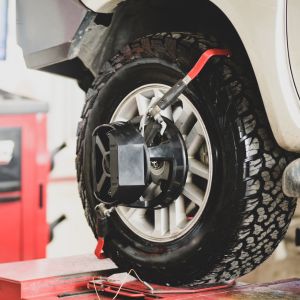Checking if your car’s wheels are aligned correctly is important in order to ensure safe and efficient driving, as well as to extend the lifespan of your tires. One way to check if your wheels are aligned correctly is by observing your car’s behaviour while driving on a flat, straight road. If your car is pulling to one side or the other, or if the steering wheel is off-centre when driving straight, it may be an indication that the wheels are not properly aligned.
Additionally, uneven or rapid tire wear can also be a sign that the wheels are not aligned correctly. Another way to check for a proper wheel alignment is by observing the steering wheel, if it vibrates or shakes while driving at high speeds, or if the steering feels loose or unresponsive, it may be an indication that the wheels are not aligned correctly.
To ensure that your car is running as smoothly as possible, it is recommended to have a professional mechanic perform an alignment check using specialized equipment such as an alignment rack, camber gauge, and toe gauge.
Steps to check your car’s wheels are aligned correctly

To check if your car’s wheels are aligned correctly, you can look for signs such as:
Your car pulling to one side or the other while driving on a flat, straight road. This can be an indication that the wheels are not properly aligned, and one or more of them may be pointing in a slightly different direction than the others. This can make it difficult to keep the car going straight and can cause uneven tire wear.
The steering wheel is off-centre when driving straight: If the steering wheel is not centred when you are driving straight, it can be an indication that the wheels are not properly aligned. This can make it difficult to keep the car going straight and can cause uneven tire wear.
Uneven or rapid tire wear: If you notice that one or more of your tires are wearing down more quickly than the others, or if the tread is wearing down unevenly, it can be an indication that the wheels are not properly aligned. This can cause your tires to wear out more quickly and can also reduce your car’s handling and stability.
The steering wheel vibrates or shakes while driving at high speeds: If you notice that the steering wheel vibrates or shakes while you are driving at high speeds, it can be an indication that the wheels are not properly aligned. This can make it difficult to keep the car going straight and can cause uneven tire wear.
The steering feels loose or unresponsive: If you notice that the steering feels loose or unresponsive, it can be an indication that the wheels are not properly aligned. This can make it difficult to control the car and can cause uneven tire wear.
In addition to these signs, you can also have a professional mechanic perform an alignment check. A mechanic will use specialized equipment such as an alignment rack, camber gauge, and toe gauge.
These tools allow the mechanic to measure the angles of the wheels and make precise adjustments to bring them back into proper alignment. They will also check the suspension and steering components to ensure they are in good condition and make any necessary repairs. They will adjust the wheels to the manufacturer’s specifications to ensure your car is running as smoothly as possible.
Equipment to check wheel alignment

There are several types of equipment that a mechanic may use to check wheel alignment. Some of the most common include:
Alignment rack: This is a large, elevated platform that the car is placed on for the alignment check. It features four adjustable turntables that the wheels rest on, allowing the mechanic to rotate the wheels and make precise adjustments.
Camber gauge: This gauge measures the angle of the wheel in relation to the vertical plane. A negative camber angle indicates that the top of the wheel is tilted inward, while a positive camber angle indicates that the top of the wheel is tilted outward.
Toe gauge: This gauge measures the angle of the wheel in relation to the centerline of the car. Toe-in means that the front of the wheel is closer together than the rear and toe-out mean the front of the wheel is farther apart than the rear.
Caster gauge: This gauge measures the angle of the steering axis in relation to the vertical axis. A positive caster angle indicates that the steering axis is tilted forward, while a negative caster angle indicates that the steering axis is tilted backwards.
Levelling gauge: This gauge helps measure the levelness of the vehicle, and helps to ensure that the vehicle is sitting level on the alignment rack
Thrust angle gauge: This gauge measures the angle of the rear wheels in relation to the centerline of the car. It helps to ensure that the rear wheels are pointing in the same direction as the front wheels.
Most of the above-mentioned equipment is part of a wheel alignment machine and is used to check and adjust all alignment angles. These tools allow the mechanic to make precise adjustments to the wheels’ alignment and ensure that they are properly aligned to the manufacturer’s specifications.
Frequently Asked Questions
Q1. How can I check if my car’s wheels are aligned correctly?

Ans: To check if your car’s wheels are aligned correctly, you can look for signs such as your car pulling to one side or the other while driving on a flat, straight road, the steering wheel is off-centre when driving straight, uneven or rapid tire wear, the steering wheel vibrating or shaking while driving at high speeds, and the steering feel loose or unresponsive. Additionally, you can also have a professional mechanic perform an alignment check and make any necessary adjustments to bring your wheels back into proper alignment.
Q2. What equipment is needed to check wheel alignment?
Ans: To check wheel alignment, a mechanic typically uses specialized equipment such as an alignment rack, camber gauge, and toe gauge. These tools allow the mechanic to measure the angles of the wheels and make precise adjustments to bring them back into proper alignment.
Q3. How long does it take to check wheel alignment?
Ans: The time it takes to check wheel alignment can vary depending on the type of car and the specific issues that need to be addressed. Typically, a wheel alignment check can take anywhere from 30 minutes to an hour, however, if additional repairs are needed, it can take longer. It is best to check with your mechanic for an estimate of how long the alignment check will take.

